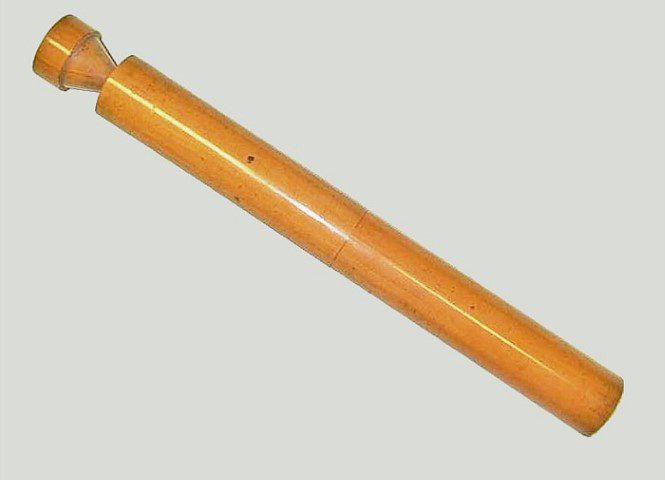MAS Ahmed
Romford, United Kingdom
Victoria Turnock
London, United Kingdom

No other symbol is as entwined with the concept of being a doctor as the stethoscope. It is currently one of the most widely used tools that doctors and nurses use for diagnostic purposes. Before its invention auscultation was done by placing the ear and head against the patient’s chest, an awkward technique, especially when the patient was obese. When the French doctor Rene Theophile Hyacinthe Laennec was faced with the prospect of auscultating an obese young woman with “general symptoms of a diseased heart,”1 he avoided the inappropriateness and embarrassment of direct auscultation by rolling up a piece of paper and placing it on her chest. To his delight the sounds were not only clear but also amplified. He then developed his idea into a hollow wooden monaural tube with a funnel at one end (pictured). There were three parts, the central shaft, the funnel shaped piece for listening to the lungs, and an extra plug piece with a brass tube that could be put into the funnel to listen to the heart. The stethoscope was 12.6 inches long, 1.5 inches wide, and the central lumen throughout its length was 3/8 inch. Thus in 1816 the first stethoscope was born.1,2
Many developments and modifications were made as the use of the stethoscope became more popular. In 1828 Pierre Adolphe Piorry included the concept of the diaphragm, whereby an ivory chest piece acted as a pleximeter. The shapes of the bell and chest piece were changed, as well as the materials used to construct the instrument.2
The next important development was the binaural stethoscope. This was invented by Irish doctor Arthur Leared in 1851. George Phillip Camman further refined it in 1853 and wrote a paper on diagnosis by auscultation,3 now much improved with the novel binaural stethoscope.4 As with any new invention there was at first much skepticism—would there not be hearing imbalance due to using both ears to listen? But these fears proved unfounded, and the use of the new binaural stethoscope became widespread.
The next development, by Dr. Robert Bowles in 1894, was combining the diaphragm with the bell. This “combination” stethoscope remains the basis of those still used today.
The year 1945 brought the Rappaport and Sprague design, in which two hearing tubes remain side by side before entering the dual chest piece, one side for listening to the heart, the other to the lungs. Then came the most widely known model of our time, the Littman stethoscope. In 1961 Dr. David Littmann produced and described his version of the “ideal” stethoscope:
An open chest piece for the appreciation of low-pitched sounds, a closed chest piece with a stiff plastic diaphragm to filter out low-pitched sounds, firm tubing with a single lumen bore, the shortest practical overall length, a spring with precise tension to hold the ear tubes apart, and light and convenient to carry and use.5
To the user the Littmann stethoscope presents the challenge of having to master the subtle art of the “tunable” diaphragm. This involves placing the diaphragm lightly against the patient in order to increase the loudness of low frequency noises, whereas if the diaphragm is pushed firmly against the chest wall the noises of higher frequency can be heard.
The lowly stethoscope is a mere refinement of one of the most basic laws of physics, the transduction and amplification of sound. Yet it has had one of the major impacts on modern medicine. Most diagnoses are made from the history and physical examination, and without listening with the stethoscope we would not be able to diagnose many conditions and diseases. Laennec indeed is the “father of chest medicine,” but the impact of his simple invention ranges much farther.
References
- Roguin, A. Rene Theophile Hyacinthe Laënnec (1781–1826): The Man Behind the Stethoscope. Clin Med Res. 2006; 4: 230-5.
- Weinberg, F. The history of the stethoscope. Can Fam Physician. 1993; 39: 2223-4.
- Peck, P. “Dr. Cammann and the binaural stethoscope. J Kans Med Soc 1963; 64: 121-3.
- Cammann. Pneumatic treatment of disease, with Cases. Trans Am Climatol Assoc Meet. 1890; 7: 47-56.
- Littmann, D. An Approach to the Ideal Stethoscope. JAMA. 1961; 178: 504-5.
MAS AHMED, MD, has been a consultant pediatrician with interest in childhood neurology at the Queen’s University Hospital since 1998. He received training in pediatrics and in particular pediatric neurology at different teaching hospitals, including York Hill Hospital Glasgow and Great Ormond Street Hospital in England. His particular interest is childhood epilepsy and childhood headaches. He has taken different clinical and managerial pediatric responsibilities, including Pediatric Medical Student Lead, Pediatric Research & Development Lead, Pediatric Audit Lead, Royal College of Pediatric and Child Health Tutor, and Pediaitric Clinical Director at the Queen’s University Hospital.
VICTORIA TURNOCK, MA (Cantab), is currently in her penultimate year of study for her MBBS (MD) degree at Barts and The London School of Medicine and Dentistry in London, UK. She graduated from the University of Cambridge in 2008 with a 2.1 degree in Natural Sciences (Pathology). Her interests and future career possibilities include geriatrics, palliative care, and the history of medicine.

Leave a Reply